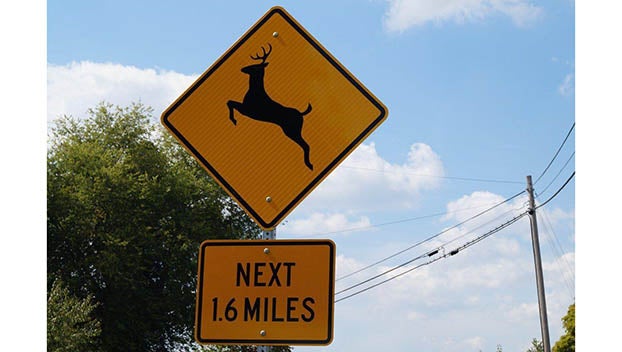The annual fall “Antler Alert” has been issued by the Kentucky Transportation Cabinet (KYTC) to remind drivers the peak season for deer-vehicle collisions on the state’s highways is now upon us.
“As our traffic engineers review data for crash trends across the Commonwealth, the increase in deer-vehicle collisions in October, November, and December is noticeable, with a peak in November,” said Transportation Secretary Jim Gray. “That’s why we take time each year to remind drivers to use extra caution now through December as deer and other wildlife are on the move. While deer can show up at all hours, they create a particular hazard at dusk and at night when visibility is not the greatest.”
Kentucky Department of Fish and Wildlife Resources acting deer program coordinator Joe McDermott points out, deer mating season is triggered by shorter days and cooler nights, putting deer on the move. Farmers harvesting crops also force deer to range farther afield for forage and hiding places.
“With the onset of fall comes the breeding season, or rut, for white-tailed deer,” McDermott stated. “As the rut approaches, bucks begin chasing does to breed. Deer essentially have blinders on during this time, which makes them particularly susceptible to motor vehicle collisions.”
In addition to vehicle damage, deer can be hazardous to humans. They contribute to about 200 deaths on America’s highways every year.
In Kentucky, 3,084 highway crashes involving deer were reported to law enforcement agencies in 2022, up about 100 from 2021. There were four reported human fatalities and 20 serious injuries due to deer collisions last year.
KYTC offers these tips:
- Slow down immediately upon spotting a deer crossing the road; they tend to travel in groups.
- Don’t swerve to avoid a deer, which can result in a more serious crash with an oncoming vehicle or roadside object.
- In the event of a crash, keep both hands on the wheel and apply brakes steadily until stopped.
- Always wear a seat belt.
- Keep headlights on bright at night unless other vehicles are approaching.
- Eliminate distractions while driving: Phones down!
- Drive defensively, constantly scanning the roadside, especially at dawn and dusk, when deer are most active.
Report all deer-vehicle collisions to police, as KYTC traffic engineers use crash data to place deer-crossing warning signs and other safety measures.






